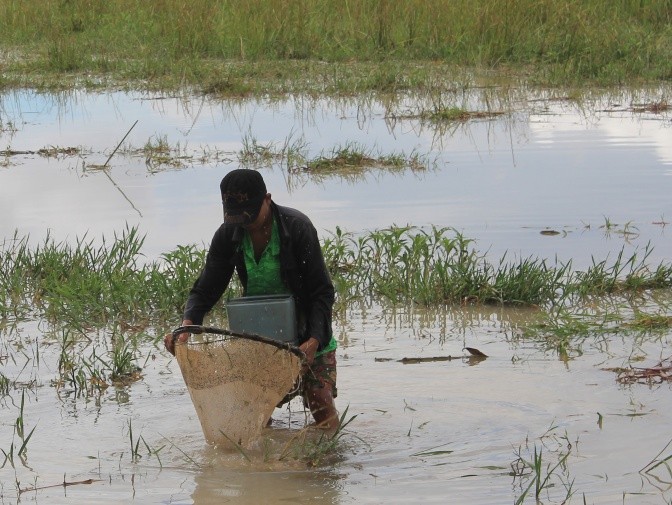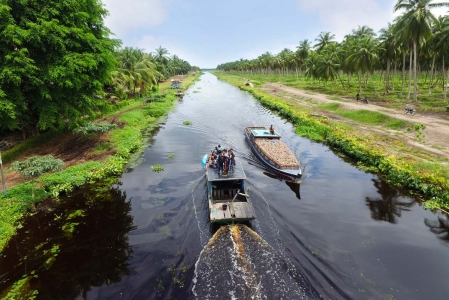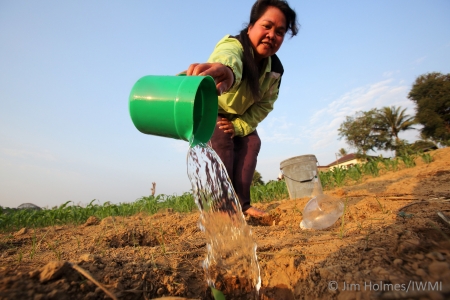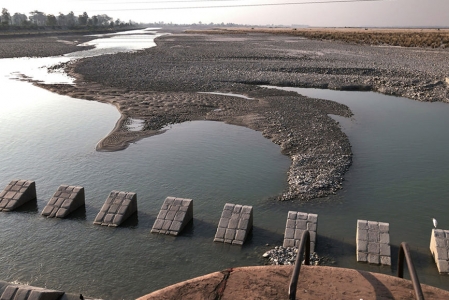This post was originally published on the CGIAR Development Dialogues ‘Talking Science‘ Blog Competition and won second prize.
Like thousands of villages throughout the Mekong region, Kiat Ngong in southern Laos is surrounded by rice fields. In nearly all the households are farmers and rice is the mainstay of their diets and livelihoods. However, the village rice fields are not only important for rice, they also harbour a large number of aquatic species (e.g. fish, frogs, insects, snails and plants), that are caught to supplement the diets of the farmers and their families. From an individual rice field, the daily harvest of this wild food is usually modest and so, unlike the rice, it goes unrecorded in government statistics. Yet this “invisible fishery” is critically important for the peoples’ wellbeing, providing them with vital protein and micro-nutrients essential for their health.
 A boy fishing in the “invisible fishery” in southern Laos. Matthew McCartney/IWMI.
A boy fishing in the “invisible fishery” in southern Laos. Matthew McCartney/IWMI.In some places in Laos, traditional rice fields have been cultivated continuously for many hundreds of years. However, as populations grow and the need for economic development increases, the Laos government, in common with the other countries in the region, wants to produce more rice. To do so they plan to increase the area under formal irrigation and use more fertilizers, pesticides and herbicides. The concern is that such practices will kill off the fish and other beneficial organisms, thereby depriving people in villages, like Kiat Ngong, of a vital source of nutritious food. While farmers may ultimately grow more rice, they may actually be less healthy and worse off than they were previously.
Achieving a balance
This example serves to remind of us of three important things. First, that ecosystem services, such as wild food, are provided not just by naturally pristine ecosystems but also by “agricultural ecosystems”. Second, that just like the invisible fishery of the Mekong, many of these services go unnoticed by officialdom and so are often neglected in formal decision-making processes. Third, that although the need to feed more people is pressing, simply increasing production is not the answer. In this case, producing more rice should not come at the cost of the living resources on which so many people depend. Ways to sustain changing human demands and simultaneously maintain natural resources must be found.
The key to sustainable development is achieving a balance between the exploitation of natural resources for socio-economic development and conserving those ecosystem services that are critical to everyone’s wellbeing and livelihoods.
The concept of ecosystem services was largely unrecognized outside of academic circles when the Millennium Development Goals were crafted. Now, as the global focus switches to the Sustainable Development Goals, it is widely recognized that the key to sustainable development is achieving a balance between the exploitation of natural resources for socio-economic development and conserving those ecosystem services that are critical to everyone’s wellbeing and livelihoods. There is no simple way to identify this balance but, in any given situation, an understanding of how ecosystem services contribute to livelihoods and who benefits and who loses from development interventions is essential.
For many years IWMI has undertaken research on wetlands in Africa and Asia. Researchers study their contributions to livelihoods, and the possible impacts of agriculture on wetland ecosystem services. Ultimately, much of the work has been about trying to identify the appropriate balance for sustainable development. For example, we have developed an index called the Working Wetland Potential, which provides a pragmatic approach to identifying and analysing the biophysical and socio-economic factors that link people, agriculture and wetlands. More recently, we have worked closely with partners, including Wetlands International, on an Integrated Framework that attempts to link wetland conservation with poverty eradication.
Sustainable use, over conservation
Much of IWMI research has been reported to the Ramsar Convention which seeks international cooperation for the conservation and “wise-use” of wetlands. Established in 1971 primarily to conserve wetland habitat for water birds, the position of the convention has gradually shifted over the years to focus increasingly on the sustainable use of wetland resources. IWMI has been a partner of Ramsar since 2005 and has influenced and provided input to a number of Ramsar resolutions. Though not legally binding, these resolutions have been adopted by all the 168 member countries of Ramsar and are intended to guide the management of their wetlands. This year, Ramsar, IWMI and FAO collaborated closely in developing messages for World Wetlands Day (2nd February) which had the theme Wetlands and agriculture: partners for growth, a stance that would have been unthinkable for the convention just a few years ago.
Perceptions of ecosystem value are changing slowly. Increasingly, the recognition that conservation efforts must incorporate people and that, conversely, development cannot be at the cost of ecosystems, is becoming the norm. Still, environmental degradation remains too widespread. As the people of Kiat Ngong will attest, in a fast changing world, striking a good balance between conservation and development - protecting an invisible fishery - is not easy. However, getting the balance right is essential for the sake of both current and future generations.














Comments
Perceptions of ecosystem value are changing slowly. Increasingly, the recognition that conservation efforts must incorporate people and that, conversely, development cannot be at the cost of ecosystems-but in practice particularly third world countries like Bangladesh behind of that-mega agricultural development build to transformed wetlands in to dry lands in the name of development, the engineering approach stile continued, water development dominated by the engineers those who are reluctant to understand ecosystems and sustainable development they bog down with ‘Project life cycle” (25years or less) they don’t bother for future!